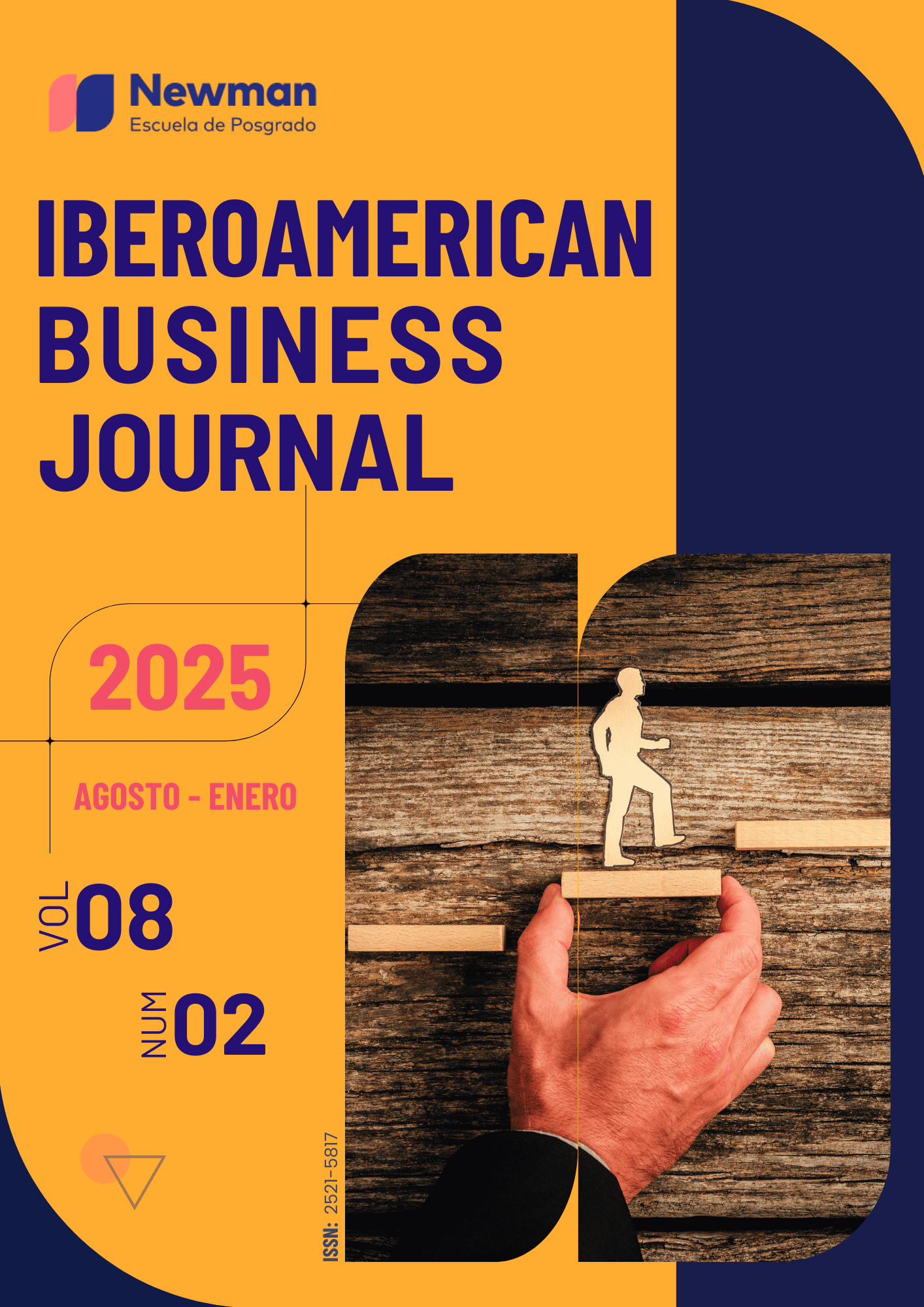Empleo de la metodología Kanban y el flujo de trabajo de compañías limeñas
DOI:
https://doi.org/10.22451/5817.ibj2025.vol8.2.11092Resumen
Objetivo: Determinar la relación entre el empleo de la metodología Kanban y el flujo de trabajo en compañías limeñas. Metodología: La investigación abordó un alcance correlacional, diseño no experimental, se empleó como técnica la encuesta para recopilar información sobre las variables y como instrumento el cuestionario que representa la herramienta para obtener respuestas. Respecto al análisis de datos fueron analizados mediante el software Excel y SPSS, mediante el uso de la prueba estadística Rho de Spearman para la comprobación de hipótesis planteadas. Resultados: Los datos verifican que el 60.0% considera que el método Kanban es eficiente, mientas que el 65.0% considera como adecuado el flujo de trabajo, también se identificó que el uso del método Kanban confirma un vínculo directo y significativo hacia la mejora de procesos (p=0,021; r=0,511), rendimiento del personal (p=0,003; r=0,621), también hacia la mejora de servicios (p=0,001; r=0.671) con una significancia menor a 0.050. Conclusión: Se demuestra que el uso del método Kanban sostiene un vínculo directo y significativo hacia el flujo de trabajo (p=0,001; r=0,671), ello confirma la hipótesis planteada.
Descargas
Citas
Ahsan, M., Rizvan, R., & Ahmed, S. (2023). Implementing lean manufacturing for improvement of operational performance in a labeling and packaging plant: A case study in Bangladesh. Results in Engineering, 17, 1-14. doi:10.1016/j.rineng.2022.100818
Baker, H., Kaddumi, T., Nassar, M., & Suleiman, R. (2023). Impact of Financial Technology on Improvement of Banks’ Financial Performance. Journal Risk Financial Managment, 16(3). doi: 10.3390/jrfm16040230
Barcaui, A., & Monat, A. (2023). Who is better in project planning?Generative artificial intelligence or project managers? Project Leadership and Society, 4(3), 1-12. doi: 10.1016/j.plas.2023.100101
Cáceres, Y., Malone, A., Zeballos, E., Huamani, N., Andia, A., & Pinedo, D. (2021). Pandemic response in rural Peru: Multi-scale institutional analysis of the COVID-19 crisis. Applied Geography, 134(12), 1-9. doi:10.1016/j.apgeog.2021.102519
Candela, L., Grossi, V., Manghi, P., & Trasarti, R. (2021). A workflow language for research e-infrastructures. International Journal of Data Science and Analytics, 11, 361–376. doi: 10.1007/s41060-020-00237-x
Castellano, L. (2019). Kanban. Metodología para aumentar la eficiencia de los procesos. 3C Tecnología. Glosas de innovación aplicadas a la pyme,, 8(1), 30-41. Recuperado de: https://dialnet.unirioja.es/servlet/articulo?codigo=6866058
Chakravarthi, K., Shyamala, L., & Vaidehi, V. (2022). TOPSIS inspired cost-efficient concurrent workflow scheduling algorithm in cloud. Journal of King Saud University - Computer and Information Sciences, 34(6), 2359-2369. doi: 10.1016/j.jksuci.2020.02.006
Chmiel, W., Derkacz, J., Jedrusik, S., Mikrut, Z., & Niemiec, M. (2022). Workflow management system with smart procedures. Multimedia Tools and Applications, 81(10), 9505–9526. doi: 10.1007/s11042-021-11658-6
Dhiman, H., Nemoto, Y., Fellmann, M., & Röcker, C. (2023). Beyond productivity and efficiency: design tools, methods and frameworks for psychological well-being, and (un)exploited potentials to assist employees at work. Frontiers in Computer Science, 3(1), 1-19. doi:10.3389/fcomp.2023.1129087
Dominguez, J., Montoya, J., Bravo, M., & Paredes, A. (2023). Estrategia lúdica de aprendizaje para el control de sistemas de producción desde un enfoque Lean: El uso del sistema de tarjetas Kanban. Revista EIA, 20(40), 1-21. doi: 10.24050/reiav20i40.1672
García, J., Realycasquez, A., García, P., Pérez, M., Blanco, J., & Jiménez, E. (2019). Effects of Human Factors and Lean Techniques on Just in Time Benefits. Sustainability, 11(7), 1-20. doi: 10.3390/su11071864
González, W., & Vilchez, R. (2021). Factores del desempeño laboral del personal administrativo en universidades nacionales experimentales. Pensamiento & Gestión(51), 54-74. doi: 10.14482/pege.50.658.155
Habib, M., Rizvan, R., & Ahmed, S. (2023). Implementing lean manufacturing for improvement of operational performance in a labeling and packaging plant: A case study in Bangladesh. Results in Engineering, 17(12), 1-14. doi: 10.1016/j.rineng.2022.100818
Kristoffersen, E., Mikalef, P., Blomsma, F., & Li, J. (2021). Towards a business analytics capability for the circular economy. Technological Forecasting and Social Change, 171(12), 1-17. doi: 10.1016/j.techfore.2021.120957
Lakshmanan, R., Nyamekye, P., Virolainen, V., & Piili, H. (2023). The convergence of lean management and additive manufacturing: Case of manufacturing industries. Cleaner Engineering and Technology, 13(2), 1-12. doi: 10.1016/j.clet.2023.100620
Lameijer, B., Boer, H., & Does, R. (2023). Continuous improvement implementation models: a reconciliation and holistic metamodel. Production Planning & Control, 34(11), 1062–1081. doi:10.1080/09537287.2021.1974114
Lee, W., Lee, S., Jin, C., & Chang, H. (2021). Development of the RACI Model for Processes of the Closure Phase in Construction Programs. Sustainability, 13(4), 1-25. doi: 10.3390/su13041806
Malinova, M., Gross, S., & Mendling, J. (2022). A study into the contingencies of process improvement methods. Information Systems, 104, 1-22. https://doi.org/10.1016/j.is.2021.101880
Marques, P., Jorge, D., & Reis, J. (2022). Using Lean to Improve Operational Performance in a Retail Store and E-Commerce Service: A Portuguese Case Study. Sustainability, 14(10), 1-19. doi: 10.3390/su14105913
Mishra, A., Abdalhamid, S., Mishra, D., & Ostrovska, S. (2021). Organizational issues in embracing Agile methods: an empirical assessment. International Journal of System Assurance Engineering and Management, 12(2), 1420-1433. doi:10.1007/s13198-021-01350-1
Nadja, D., & Talib, D. (2021). An approach to optimizing kanban board workflow and shortening the project management plan. IEEE Transactions on Engineering Management, 2(1), 1-8. doi: 10.1109/TEM.2021.3120984
Pekarcikova, M., Trebuna, P., Kliment, M., & Dic, M. (2021). Solution of Bottlenecks in the Logistics Flow by Applying the Kanban Module in the Tecnomatix Plant Simulation Software. Sustainability, 13(14), 1-21. doi: 10.3390/su13147989
Senabre, E. (2019). Adapting the scrum framework for agile project management in science: case study of a distributed research initiative. Heliyon, 5(3), 1-34. doi: 10.1016/j.heliyon.2019.e01447
Shamshurin, I., & Saltz, J. (2019). Using a coach to improve team performance when the team uses a Kanban process methodology. International Journal of Information Systems and Project Management, 7(2), 61–77. doi: 10.12821/ijispm070204
Tilocca, G., Sánchez, D., & Torres, M. (2023). Application of the theory of constraints to unveil the root causes of the limited market penetration of micro gas turbine systems. Energy and Environmental Science, 278(21), 1-15. doi: 10.1016/j.energy.2023.127717
Van, M. (2021). Training, employee involvement and continuous improvement – the moderating effect of a common improvement method. Production Planning & Control, 32(2), 132-144. doi: 10.1080/09537287.2020.1716405
Vrchota, J., Rehor, P., Mariková, M., & Pech, M. (2021). Critical Success Factors of the Project Management in Relation to Industry 4.0 for Sustainability of Projects. Sustainability, 13(1), 1-19. doi: 10.3390/su13010281
Weflen, E., MacKenzie, C., & Rivero, I. (2022). An influence diagram approach to automating lead time estimation in Agile Kanban project management. Expert Systems with Applications, 18(7), 1-10. doi: 10.1016/j.eswa.2021.115866
Zheng, K., Ratwani, R., & Alder, J. (2020). Studying Workflow and Workarounds in Electronic Health Record-Supported Work to Improve Health System Performance. Ann Intern Med, 172(11), 116-122. doi: 10.7326/m19-0871
Zorrilla, F., Meléndez, I., & Rodríguez, M. (2023). Capacitación Profesional Para la Implementación de un Sistema Kanban-Tooling Para una Industria Automotriz. RIDE. Revista Iberoamericana para la Investigación y el Desarrollo Educativo, 12(26), 1-23. doi: 10.23913/ride.v13i26.1525
Publicado
Cómo citar
Número
Sección
Categorías
Licencia
Derechos de autor 2025 Eubi Alagón Zúñiga

Esta obra está bajo una licencia internacional Creative Commons Atribución-NoComercial-CompartirIgual 4.0.
Los autores que publican en esta revista están de acuerdo con los siguientes términos:
- Los autores respetan los derechos de autor y garantizan a la revista el derecho de ser la primera publicación del trabajo al igual que licenciado bajo Licencia Creative Commons Reconocimiento-NoComercial CompartirIgual 4.0, que permite a otros compartir el trabajo con un reconocimiento de la autoría del trabajo y la publicación inicial en esta revista.
- Los autores pueden establecer por separado acuerdos adicionales para la distribución no exclusiva de la versión de la obra publicada en la revista (por ejemplo situarlo en un repositorio institucional o publicarlo en un libro), con un reconocimiento de su publicación inicial en esta revista.
- Es responsabilidad de los autores obtener los permisos necesarios de las imágenes que están sujetas a derechos de autor.
- Se les comunica los autores que todos los trabajos serán subidos al programa Turnitin para comprobar su originalidad.
















